Amaryllises are popular flowers for the holidays. They start appearing on store shelves in gift and growing kits in the fall when the holiday displays go up. They make great gifts for houseplant and gardening enthusiasts, but they are also popular as alternative (or complementary) Christmas and New Year’s decorations.
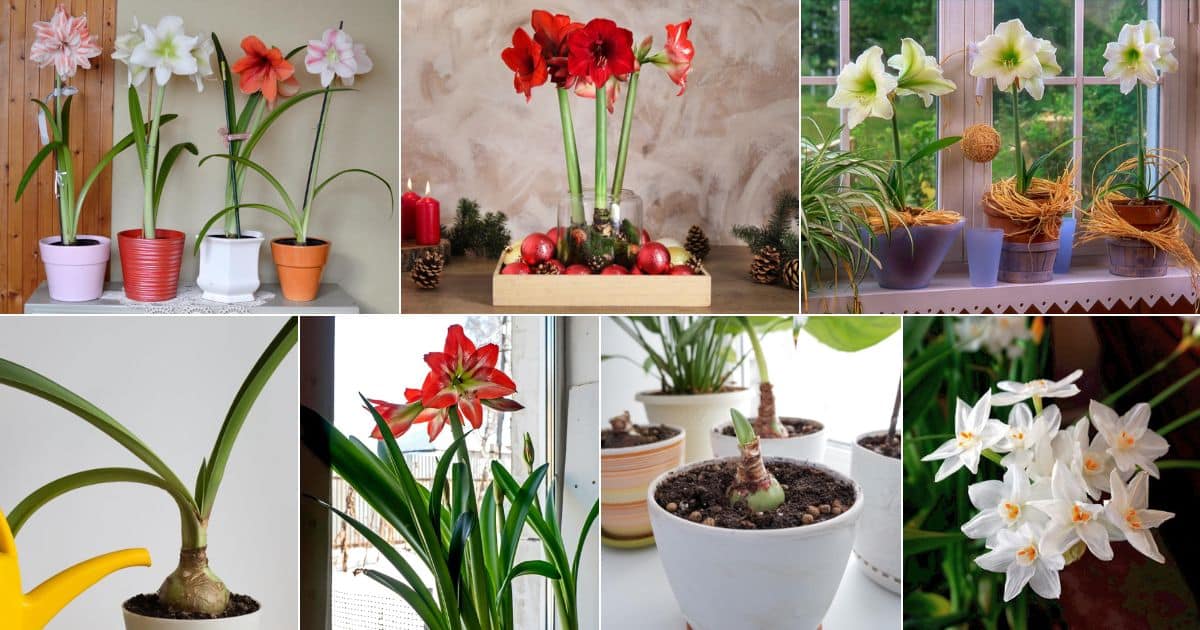
If decorations and displays are what you’re after, and you want to have your amaryllis blooming for holiday decorating, you’ll need to plan ahead and plant ahead.
When Do You Plant Amaryllis for Christmas Blossoms?

Amaryllis grow quickly and can flower anywhere between four to eight weeks after they are planted. The average is around six weeks. It’s wise to start planting in early to mid-November if you want the plant to be flowering for Christmas.
Here are some tips for a successful blooming planting:
- Amaryllises need to feel a root or pot bound to the flower. Plant your bulb(s) in a pot no bigger than one inch larger than the bulb (measured at the widest point of the bulb)
- The pot should be twice as tall as the bulb so the roots have enough room to grow
- It’s important that the pot has drainage holes
- Plant in a good quality potting mix
- An amaryllis planting kit should have all you need to start the bulb and the pot will be the right size
- The bulbs should not be completely covered—about one-third of the bulb’s top should be sitting above the soil
- When you first plant your bulb, take it to the sink and thoroughly water the plant until the soil is wetted all the way through
- Leave the pot in the sink for an hour or so to allow all excess water to drain, then put the pot on a saucer and move it to a place with bright, indirect light
- Do not overwater amaryllis bulbs
- Let the top of the soil dry out between waterings.
- Amaryllis prefers a cooler room over a warmer room (around 65 F or 18 C)
Plant More than One Bulb for More Reliable Blooms
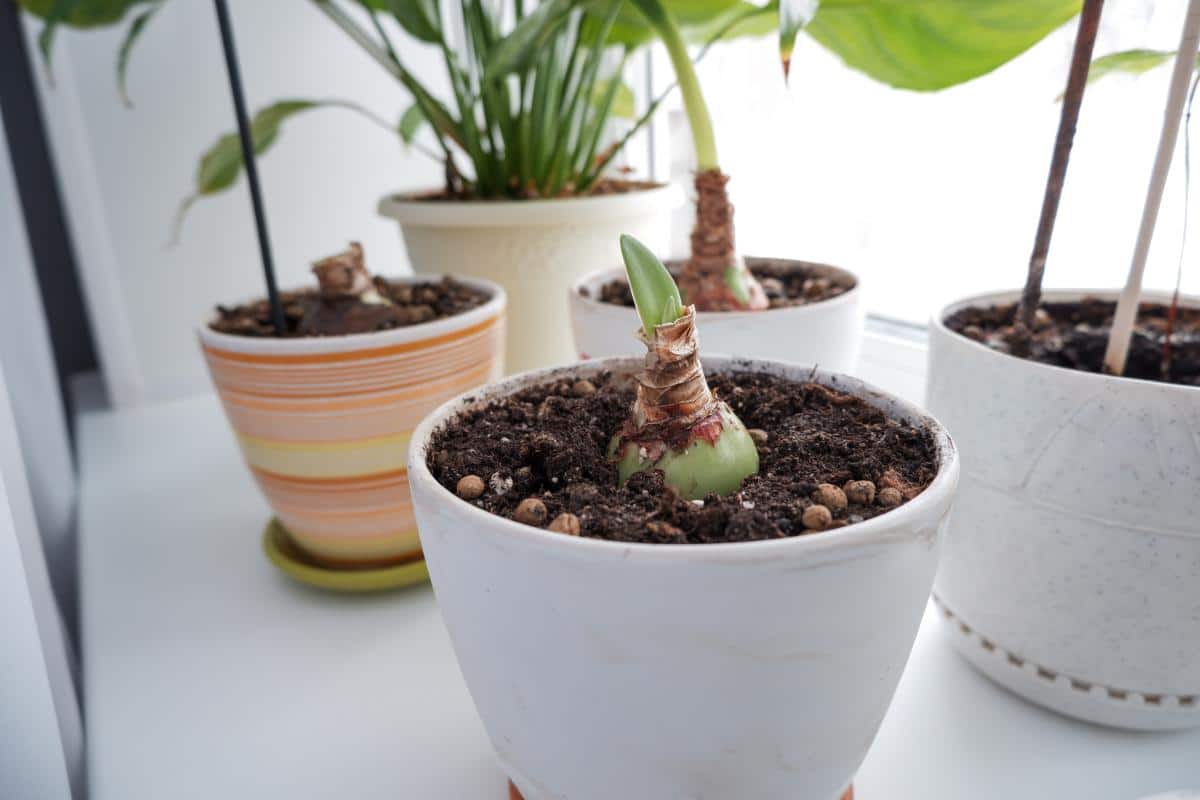
Each amaryllis blossom will last for about two to three weeks. And of course, we can plan the best we can, but everyone’s growing conditions are a little different in their home, and plants will do what each individual plant naturally does.
Doing what comes naturally, of course, means the bulbs can have a little bit of a mind of their own. If you really want to hedge your bets for blossoms for Christmas (and potentially through New Year’s), plant more than one bulb.
- The number of flowers that one bulb grows is related to the bulb size
- Choose larger bulbs for more flowers
- Flower stalks may also grow and bloom successively, so large bulbs with more flower stalks also increase the chances of having flowers for the holidays
Plant in Succession to Hedge Bets for the Right Bloom Time
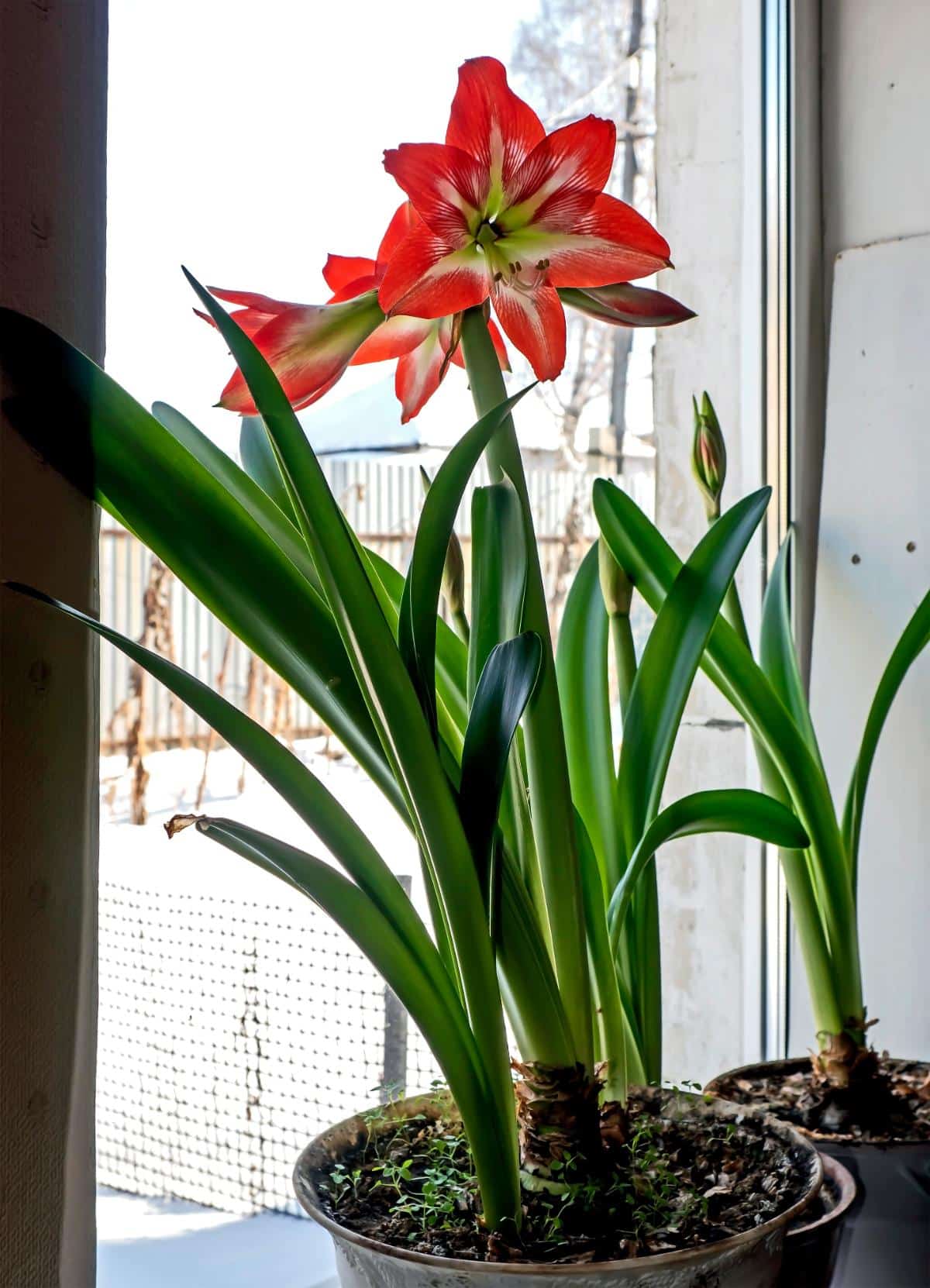
Another way to increase the likelihood of having your amaryllis bulb blossom when you want it to is to plant a few bulbs in succession.
Plant one or more bulbs every week or every two weeks. If you choose to do this, start earlier than November—mid to late October—and plant weekly or biweekly through the month of November.
At the very least, you’ll have a long succession of blooms to enjoy over many weeks. If you plant every week, you have the best chance of hitting the holidays just right.
If you plant every two weeks, you should have at least one flower in bloom consistently for as many bulbs as you started. That could mean well over a month of beautiful blooms!
- Amaryllis bulbs can be on the more expensive side, but with good aftercare, your bulb can bloom again
- Kits make planting easy, but you often can’t inspect the bulb in kits
- Bare amaryllis bulbs are cheaper, and you may be able to pick through to find the best (if you’re buying in person at a garden center or store)
- You can usually get two blooms per year; then the plant needs to die back from its foliage to store energy to grow again
- You can just be done with the plant after the first bloom and let it go dormant if you don’t care to manage it that much
Plant Different Varieties to Increase the Odds
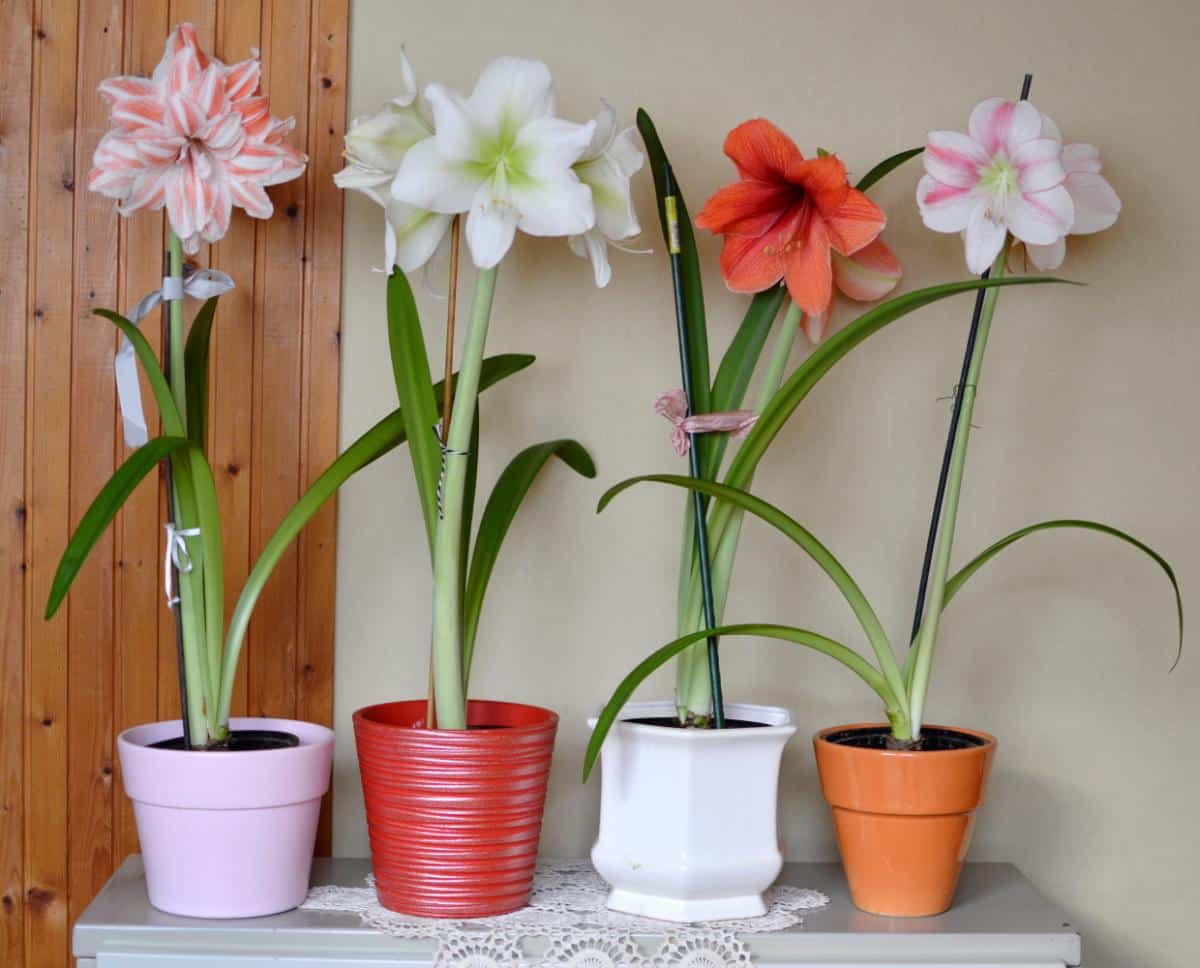
Different varieties of amaryllises have different growing and bloom times, so you can increase your chances of having blossoms on Christmas Day (or New Year’s Day, or both) by planting more than one variety.
Pick out a few that strike your fancy.
- Amaryllis bulbs can be put into dormancy after they die back
- You can save them and regrow them for many years
- You will have the widest variety of flowers by shopping for single bulbs and not kits
Fertilize Regularly to Boost Blooms
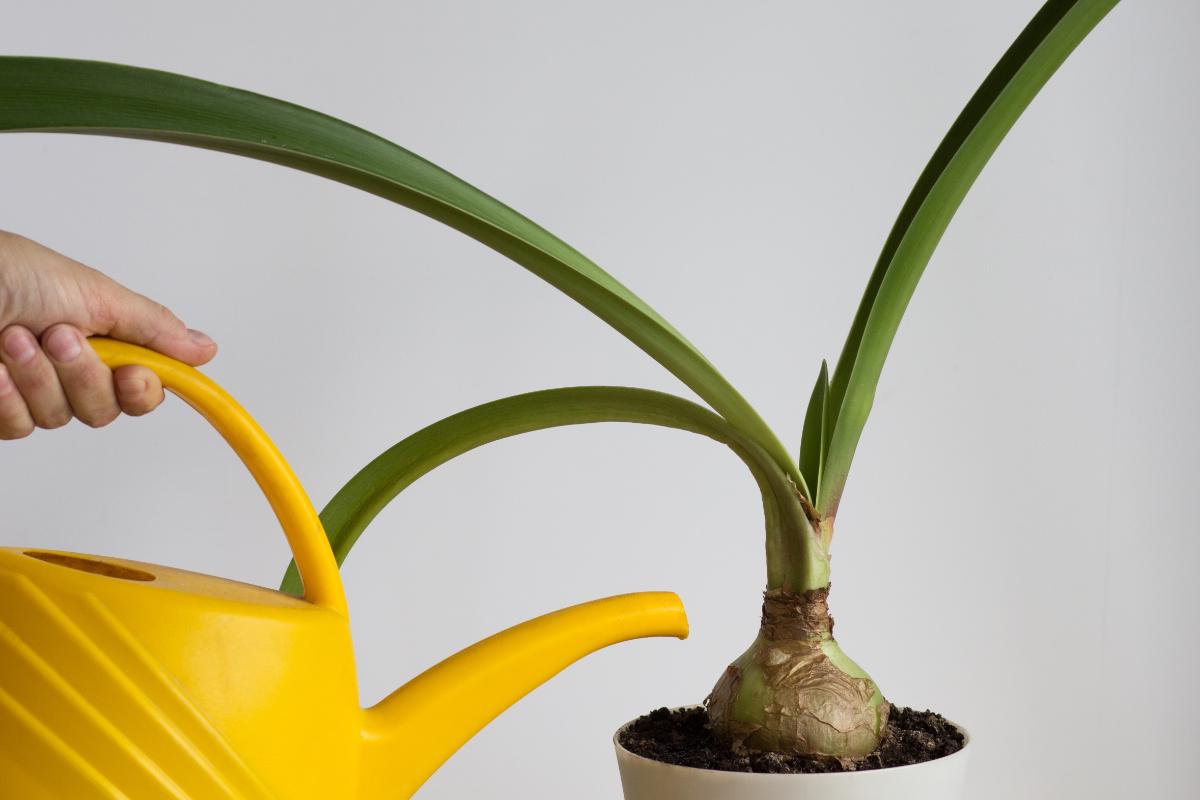
To speed up blossoming and give the plant what it needs to support those large flowers, fertilize your amaryllis every time you water it.
Start giving the bulb fertilizer in its water when you see new green growth poking out of the bulb (some bulbs come already sprouting, so fertilize those when you pot them—flowering takes a lot of energy out of a plant).
Even newly purchased amaryllis bulbs should be fertilized.
- Use a water-soluble fertilizer
- Phosphorous is what promotes blossoming in amaryllis, so choose a fertilizer with a high phosphorous content
- On the fertilizer label, phosphorous (abbreviated as “P”) will be the middle number
- For example, if the label has three numbers like 15-30-15, the middle number is the phosphorous content—the 30
- Phosphorous content should be at least as high as the other two, preferably higher
- Mix the fertilizer at half the strength recommended on the label and feed it every time you water once the plant starts growing
- Do not overwater amaryllis, or the bulb will rot
- Only water when the top inch of soil is dry
- Avoid pouring water on the neck of the bulb (the exposed part above the soil)
A Few Final Tips to Keep Amaryllis Looking Lovely
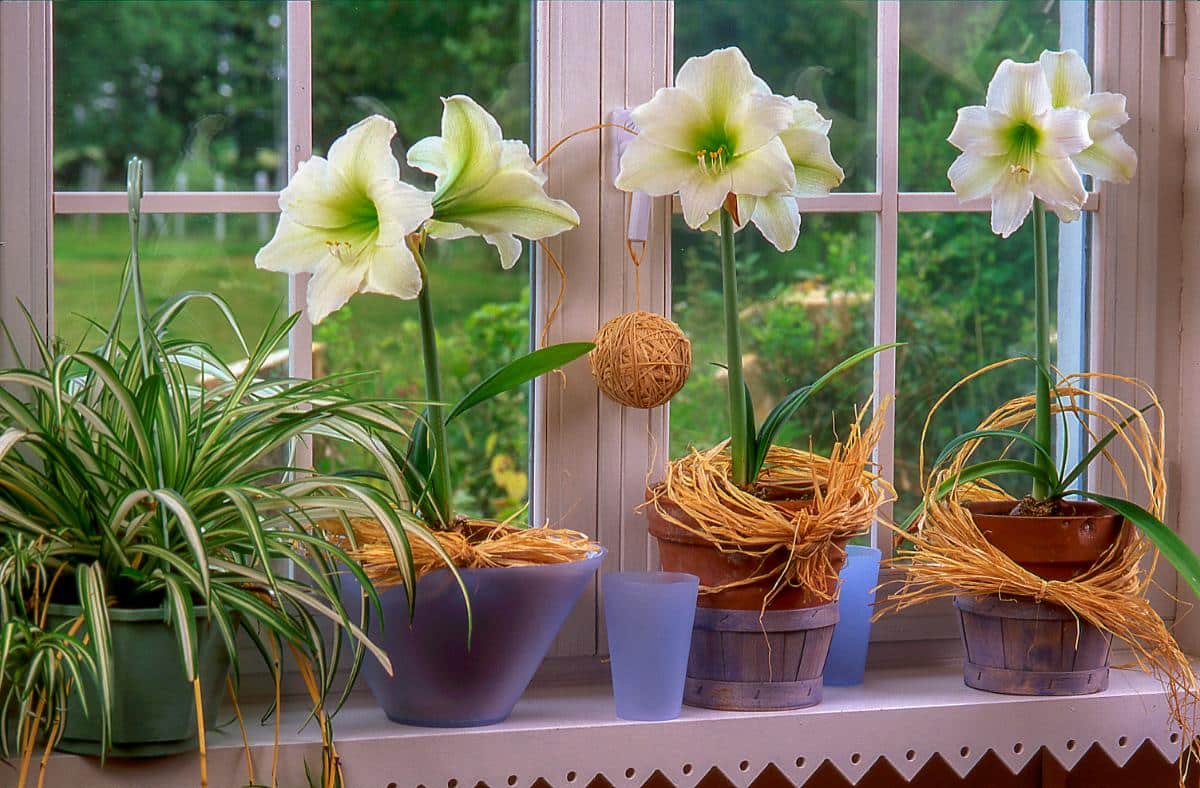
- Amaryllis grow quickly and bend toward the light, so turn the bulb every day or two, so it grows evenly and straight up
- Stalks are tall, and flowers are heavy—they can be anywhere from four to ten inches in diameter
- You may need to stake the flower stalk to keep it from bending
- Give your amaryllis a pretty topiary look by gently tying or wiring the flower stalks together at the top
- Tying also helps the stalks support each other
- You can tie flower stalks together on the stake, too, which hides the stake and lends support
- Sellers are now offering unique waxed amaryllis bulbs that are ready to grow and require no watering–an interesting option!
- Amaryllises make great gifts—give kits or start some ahead to give as grown and flowering plants
- A beautiful, blooming amaryllis is the perfect holiday hostess gift

- Paperwhites are smaller but much-loved Christmas flowering bulbs, too
- Paperwhites grow similarly and in about the same bloom time as amaryllis (a little quicker)
- They complement amaryllis nicely, either together in one pot as a holiday bulb garden or set together in separate pots
- If you’re not sure if you have time to get your amaryllis to bloom exactly when you want it to, or if your started bulbs are taking longer to bloom than expected, buy a fully grown plant that is in flower at the time you want it
- You can still save the bulb from flowering full plants after it’s done to regrow for reblooming or to save for next year
After finding a caring home, a dog who lost part of his face can’t stop grinning.
A call that left Brittany Faske, a volunteer with the rescue organisation ADORE (All Dogs Official Rescue Enterprise of Houston), anxious came in January. A construction worker in Houston, Texas, noticed an injured Pit Bull with half of its face missing. According to the man, the dog hid in the bush and refused to allow anyone approach too close.
The woman was taken aback by the call and rushed to the spot. When she discovered the dog beside a ditch among the bags of food leftovers and old tyres, she realised he was in far worse condition than she had anticipated. The dog was in such horrible shape that she thought the best she could do was relieve his agony.

“This once-beautiful, big, and strong dog had been reduced to almost nothing.” He was so skinny that his ribs, hip bones, and backbone were clearly visible beneath his skin, in addition to his injuries. “He was covered in dirt and very weak,” Brittany explained to The Dodo.
The dog made a warning growl as she approached, but it didn’t startle her. She didn’t expect a different reaction from him, given the situation he was in and everything he had to go through and suffer through to remain that way.
After a while, the dog let Brittany to approach close enough to examine her injuries. The animal’s nose and snout were missing, and what was left hung in front of her face.
Brittany instantly realised it couldn’t have been an accident because the cut was so straight it could only have been made with a sharp instrument. So, that dog scenario was most likely the act of a human being, possibly the same one who left him lying there. In addition to the horrific sight of the wounds, the dog reeked of infection.
Brittany took Apollo, the dog she named, to the veterinarian after gaining his trust. Despite appearing to be in excruciating pain, the dog managed to relax and even fall asleep in the woman’s car. However, he was not yet fully safe.

The dog required immediate medical attention, and Brittany was unsure if he could handle the therapies that were to follow. However, when Apollo arrived at the clinic, he trotted around the waiting area, sniffing people and interacting with the other dogs.
Apollo had heartworm, a disorder that arises when parasitic worms move through a dog’s tissues to its heart and can lead to death if left untreated, in addition to his facial injuries.
Brittany and the vet placed food and water in front of Apollo to determine his quality of life and ability to eat properly. He could have a shot if he can do it.
Apollo ate two bowls of food and water without hesitation. Then Apollo approached the woman who had saved him and rested his head on her leg. “From that moment on, we knew he wasn’t just any dog,” Brittany explained.

Apollo eventually underwent reconstructive surgery. The dog’s exterior nose had been removed, but he still had a nasal cavity through which he could breathe. During the procedure, the veterinarian wrapped a skin graft around the exposed bone in Apollo’s nasal cavity to protect what was left of his nose. While the vet had to remove part of the dog’s top jaw and some teeth, he was still able to maintain enough of his mouth for him to eat and drink regularly.
Meanwhile, Brittany had not considered adopting the dog; she was simply concerned with the surgery and the dog’s recovery. She knew, though, that she and Apollo had formed a special link that was growing stronger by the day.
Brittany introduced Apollo to her other dogs, two males over the age of ten. “They were powerful breeds with volatile temperaments.” Two old men who are grumpy. I wasn’t sure if they could take another dog. “They were used to being just the two of them and were very protective of me,” she explained.

Once again, Apollo outperformed Brittany’s expectations. Apollo not only accepted the new dog, but he also adored the elder dogs. Another surprise element about Apollo was that he enjoyed being among others, which was unexpected given what he had been through. After that, Brittany made the obvious decision to officially adopt Apollo.
Apollo now lives a full life despite his facial injuries. His repaired nose functioned like any other dog’s nose, allowing him to breathe, smell, and sneeze normally. His reconstructed jaw does not prevent him from eating or playing.

Apollo enjoys cuddling up in the recliner with Brittany and watching TV, playing with his dog brothers, eating, and sunbathing. Furthermore, the dog received personalised training sessions at a Total Control K9 College K9 course, where he attends classes every Saturday and appears to like it.
Apollo was able to overcome his emotional traumas thanks to Brittany’s devotion, which also made him a very caring and affectionate dog. “I’ve never met a happier dog.” “You can see their trust and love in their eyes,” Brittany says.



Leave a Reply